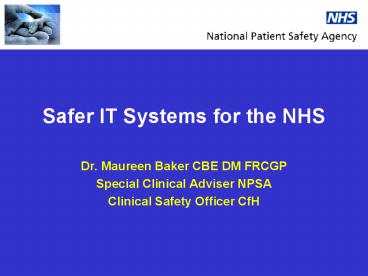Safer IT Systems for the NHS - PowerPoint PPT Presentation
1 / 21
Title:
Safer IT Systems for the NHS
Description:
617 million prescriptions dispensed by community pharmacists in year 2002-3 in ... Structured risk assessment incorporated into development processes ... – PowerPoint PPT presentation
Number of Views:22
Avg rating:3.0/5.0
Title: Safer IT Systems for the NHS
1
Safer IT Systems for the NHS
- Dr. Maureen Baker CBE DM FRCGP
- Special Clinical Adviser NPSA
- Clinical Safety Officer CfH
2
Overview
- Patient safety in Connecting for Health
- NPSA commissioned study
- Safety Management Requirements
- IT solutions to patient safety problems
- Process re-design
3
National Programme for IT (NPfIT) in NHS
- AIMS
- To deliver a 21st Century health service that is
better for patients, citizens, clinicians and
people working in the NHS through the efficient
use of ICT - To improve the convenience, quality and SAFETY of
patient-centred care by ensuring that those who
give and receive care have the right information,
at the right time
4
Why do we need it?
- Medical and clinical knowledge continually
expanding - Patients want more involvement in their care
- Traditional paper-based recording and storage
systems can no longer provide effective support
for NHS - Many hospitals and most general practices now
have some form of electronic patient record that
cannot easily be shared - Data and information not easily shared across NHS
5
Why is this important to NPSA?
- Huge potential to support clinicians in
practising safely prescribing, transfer of
information, clinical decision support - Platform to enable NPSA solutions work right
patient right care, transfer of care - Opportunity to exert major influence for safety
on 6B programme
6
Maximising safety in primary care systems
- NPSA funded study (55,000) from University of
Nottingham - Conducted during 2003
- Emerging findings conveyed to NPSA while study
on-going and influenced programme of work
7
Objectives of study
- Identify the most important safety issues
regarding GP computer systems - Assess GP computer systems in terms of these
safety features - Determine GPs knowledge, views and training
needs in relation to computerised safety features - Work with stakeholders to produce specifications
for GP computer suppliers and for training
practice staff
8
Primary care contacts
- 1 million consultations with GPs in UK every
working day (NHS Plan, 2000) - 100,000 home visits by community nurses every
day (NHS Plan, 2000) - 617 million prescriptions dispensed by community
pharmacists in year 2002-3 in England (source
PPA) - 50 million prescriptions dispensed in dispensing
practices in year 2002-3 in England (source PPA)
9
Medication errors - English general practice
- Medication error rate between 1 and 10 of all
prescriptions generated - From lower estimate could be 6,500,000 medication
errors - Estimated 1 of medication errors in general
practice are clinically significant - Could be 65,000 cases of harm in England annually
10
Results from NPSA funded study (University of
Nottingham)
- Allergy alert may not be generated
- Hazard alert generated every third prescription
- Single keystroke to over-ride alert
- No audit trail
- Not all safety functionality activated (eg
contra-indications) - Hazards generated by drop-down menus
- GPs unsure of safety functionality on systems
- Some think functionality is present when it isnt
(eg contra-indications)
11
Development of Safety Management Approach in NPfIT
- DCMO requested NPSA to conduct high-level risk
assessment of NPfIT - NPSA Risk Adviser conducted assessment early
summer 2004 - Report delivered to NPSA and NPfIT June 2004
12
Report findings
- NPfIT currently not
- Formally incorporating safety as a benefit to
drive the programme - Formally risk assessing systems and processes
- Formally risk assessing solutions to ensure no
new risks introduced - Relying on those involved to instinctively
address patient safety
13
Conclusion
- NPfIT not addressing safety in an explicit,
proactive, structured and robust manner and. - Other industries would!
14
NPfIT Action
- Work in partnership with NPSA to address safety
concerns - Safety Management Approach evolved in workshops
Autumn 2004 - Based on IEC 61508 (international standard for
safety critical software) - Agreed with and supported by NPSA
- Implemented January 2005
15
Aims of Safety Management Approach
- To deliver IT systems which improve clinical
safety. - To provide suppliers with an easy to use and
robust safety management system. - To provide Trusts with assurance and clear
guidance on the actions they need to take to
ensure systems are deployed in an effective and
safe manner.
16
Safety Management Requirements
- Every CfH product, and every product that
connects over the spine to have - End-to-end hazard assessment
- Safety justification case
- Safety closure report
- When closure report signed off, then
certificate of authority to deploy issued
17
Responsibilities
- The Director of Clinical Safety, Professor Muir
Gray, Chairs the CfH Monthly Safety Committee. - The National Patient Safety Authority (NPSA) have
seconded Dr Maureen Baker as the Clinical Safety
Officer. - Muir and Maureen will ensure liaison with the CfH
Programme Development Board and RIDs
18
IT solutions to patient safety problems
- Right patient right care
- Clinical Hand-offs
- Interface issues
- Management of investigations and results
19
Process design
- Poor processes can lead to patient safety
incidents - Automating poor processes still yields poor
results for patient safety - Clinicians need to feed into development of
systems - Change in working processes should be determined
by clinical requirements, not by the way in which
IT systems have been designed
20
Safety Principles
- Systems designed to deliver safer patient care
- Patient safety embedded at every level
specification design testing and quality
assurance implementation and use in clinical
setting - Structured risk assessment incorporated into
development processes - Aim for inherently safe systems
21
ANY QUESTIONS?
- www.npsa.nhs.uk
- maureen.baker_at_npsa.nhs.uk































